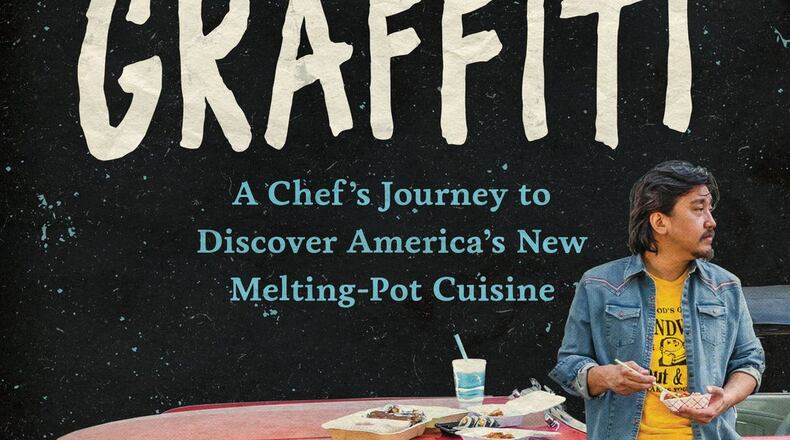To call "Buttermilk Graffiti: A Chef's Journey to Discover America's New Melting-Pot Cuisine" (Artisan, $27.50) by Edward Lee merely a cookbook would be shame.
Not because there aren’t many wonderful recipes in its 300-plus pages. But because the journey Lee takes and the stories he tells conjure writers as diverse and compelling as Alexis de Tocqueville, M.F.K. Fisher and Anthony Bourdain.
And, ultimately, as Lee writes, it’s his own improbable journey from Canarsie to Kentucky, and unlikely coupling of Korean and Southern cuisine, that form the backstory to his narrative of the cultural mash-ups that make life and food in America so fascinating.
If you don’t know, Lee is a multiple James Beard award nominee, chef/owner of 610 Magnolia, MilkWood, and Whiskey Dry in Louisville, Ky., and culinary director of Succotash in National Harbor, Md., and Penn Quarter, Washington, D.C.
He’s been on “Top Chef” and “The Mind of a Chef,” and he recently wrote and hosted the documentary, “Fermented.” His first book, “Smoke and Pickles: Recipes and Stories from a New Southern Kitchen” (Artisan, $29.95), put Lee on a national book tour that inspired the powerful, poignant, and timely chronicle that came together as “Buttermilk Graffiti.”
Lee will be in Atlanta on May 14 for a conversation about the book. As a prelude to that event, we recently talked via cellphone while Lee was waiting in an airport on his way to St. Paul, Minn.
The first thing I wondered about is how in this video-crazy time he got away with writing a narrative nonfiction book with recipes but no photos.
“I say it jokingly, but it’s kind of true. We’ve only had cookbooks with pictures for like the last 50 years — or less, really,” Lee said. “Some of my favorite cookbooks, ones I go back to again and again, don’t have pictures. That’s reason number one. But reason number two is that I got a lot of emails from people who would cook things out of the first cookbook.
“They would send me a picture of their meal and say they really liked the recipe but it didn’t come out as pretty. That upset me, because they said it tasted good. And they put all this effort and joy into it, then somehow they felt like a failure because it didn’t look like the work of a food stylist and a professional photographer.”
Just as important, the recipes in “Buttermilk Graffiti” are conjured and recreated from things like Lee’s Proustian memories of beignets in New Orleans. Or a road trip through Appalachia with Kentucky writer Ronni Lundy. Or the two “sisters” of “A Kibbeh In Clarksdale” (Mississippi), as one chapter with a recipe for cabbage rolls is titled.
“None of the recipes in this book are restaurant recipes,” Lee said. “That mean it doesn’t matter what the presentation is. Some of them are complex. But they’re all home recipes. And I want people to trust their palates and really just have fun and use their imaginations.”
Asked about the term “melting-pot cuisine” he uses to help explain the scope of the book, Lee allowed that almost any term for contemporary American cooking is limiting in some way.
“I do think that in this wonderful, complex soup that we live in called America, the strength of it all is based on diversity,” he said. “And so when we have these cultures and they rub up against each other and this food comes out of it, to me, it’s all American food.
“When my mother first arrived in New York, they lived in Brooklyn, and there were no Korean markets there. So she had to go to the Jamaican store to get these chili flakes that she used to make her kimchi. I teased my mom, and said, ‘You were like the first fusion cook.’ At that point, I know it’s just one substitution, but it’s significant. It means you’re not cooking Korean food anymore. But it’s certainly not Jamaican food. It’s American food. And it’s around us, everywhere.”
Korean-American chef/restaurateur and author of "Buttermilk Graffiti," Edward Lee in conversation with Atlanta food and restaurant writer Bob Townsend. Tickets $35, include a signed, first-edition copy of "Buttermilk Graffiti," with part of the proceeds going to Global Growers nonprofit. 7 p.m. May 14. The Highland Inn & Ballroom Lounge, 644 North Highland Ave. NE, Atlanta. eventbrite.com/e/2nd-annual-benefit-for-global-growers-buttermilk-graffiti-by-edward-lee-tickets-45120137546.
RECIPES
These three recipes from “Buttermilk Graffiti” by chef Edward Lee celebrate the new melting-pot American cuisine.
Korean Doughnuts (Hoedduck)
The Korean doughnut and the New Orleans beignet are distant cousins with the same purpose — to put a smile on your face. The dough for these doughnuts contains a lot of rice flour, which gives them a crispier crust than the typical American doughnut. The filling is different, too. The cashew nuts are savory, and the sesame seeds add a bitterness to the semisweet filling. In Seoul, you can walk through neighborhoods on a brisk autumn night and see street vendors selling hoedduck. These are pan-fried, and they are best eaten right out of the pan while still warm and crisp.
Pollo a la Brasa
True pollo a la brasa is slow-cooked over charcoal, and if you have a charcoal grill you should cook your chicken on it, rather than in the oven, as in this recipe. But it is the marinade that makes this dish so special. The chicken must be marinated overnight, which makes the chicken tender and juicy with a crust that is caramelized and salty, just the way chicken skin should be. I use Korean gochujang in the marinade because it closely resembles the Peruvian chili that is hard to find in the States.
Marinade
Recipes excerpted from “Buttermilk Graffiti” by Edward Lee (Artisan Books). Copyright © 2018.
EVENT
About the Author
The Latest
Featured





